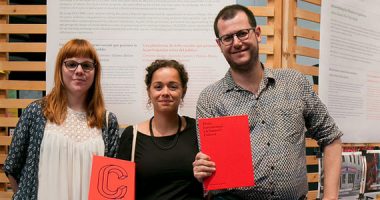
The 1973 NCAA cross country championship, Washington. Source: Flickr.
The new competition organised by the CCCB to commemorate the occasion of its 20th anniversary, the Cultural Innovation International prize, received, for its first edition, under the theme “Audience/s”, a total of 151 projects, of which 96 were finally accepted for the contest. We analyse the different origins of the projects, as well as their points in common, which sketch a certain state of affairs regarding today’s audience/s. The finalists determine certain common constants, where it is clear that the audience has ceased to be a passive entity to become a participative and, at the same time, a complex and fragmentary one.
The total number of projects submitted to the first edition of the Cultural Innovation International Prize was 151, of which 96 were accepted for consideration. In order to be accepted, projects had to meet the terms and conditions of participation, and provide all the documentation required for the assessment process. Focusing only on the projects accepted for consideration, the submissions offer with various readings. The projects come from very diverse sources, with 61 submissions from outside of Spain coming from 25 different countries. Of the 96 projects admitted, 33 were submitted in English, 18 in Catalan, and 43 in Spanish. Generally speaking, the quality of the projects was high, and the theoretical sections submitted with the projects as required by the terms and conditions now offer us a means by which to diagnose the cultural scene in Europe and the rest of the world.
All the projects accepted for competition were examined and assessed by a technical committee made up of staff from various CCCB departments. The evaluation procedure was based on the same selection criteria that the jury will use, so as to ensure the consistency of internal discussions. It emphasised innovation in regard to audiences, which was the theme chosen for the inaugural Prize. Once each member had personally read, assessed, and ranked the projects, the committee met several times in order to come up with a shortlist of the 20 most interesting and highest-ranking projects, which was then whittled down to a list of 10 finalists. The assessment took into account the quality and originality of the projects, as well as their feasibility. Unfortunately, it was necessary to exclude some very interesting projects that did not meet the requirement of not having previously being implemented, given that they were already being launched or carried out at other centres or museums.
Although “Audience/s” is a very broad and complex theme, we were able to identify several characteristics that were shared by many of the projects submitted:
- Projects tended to unanimously agree with the idea that audiences – and the concept of audiences – have changed in recent years due to the emergence of the category of “prosumers” who are activated by new digital tools, and to the effects of the economic crisis which also entails a political, ethical, environmental, and cultural crisis.
- The audience – or part of the many audiences that exist – is no longer a passive entity. Instead, it responds to the great “call for participation” in cultural events and in their dynamics of creation, production, representation and distribution, which has taken hold over the past ten years.
- Participation processes offer a wide range of options and strategies spanning from 2.0 marketing to co-creation with users. This raises a series of dilemmas that are changing the ways in which knowledge is created, programmed, produced, consumed and distributed.
- Cultural consumption is starting to become particularly complex due to audience fragmentation in the era of access. There no longer seems to be any such thing as a universal “audience“, to the extent that even a single person can be many types of audiences at once, depending on the circumstances.
- There is some degree of consensus about audiences that have been “neglected” by cultural institutions, with a particular emphasis on the 19-35 age group, which is in a sense the most immediate and perhaps decisive sector, as well as children and teenagers, and also senior citizens and people with some type of disability.
If we leave aside content and turn our attention to the formats and formal aspects of the projects submitted, we can draw the following conclusions:
- The practical proposals submitted with each project show a tendency to mix or hybridise genres, formats and devices.
- The proposed solutions were based on different operational levels: virtual exhibitions, audience-generated exhibitions, performative lectures, digital platforms, mobile applications (apps), documentation processes, critiques of and alternatives to the “white square” model, temporary breaks in programming and emptying of spaces, new models for the use of social networks and media, prototypes, lab-formats, etc.
- It could be said that there was nothing new in absolute terms, perhaps because the idea of absolute novelty is an unsustainable and to some extent impossible ideal, even though the quest for “newness” as one of the categorical imperatives of modernity is still valid, at least as a question or problem.
- Other aspects worth mentioning are the strong influence of “relational aesthetics”, of the “educational turn” in curatorial activity, and of experimental, open proposals that put the emphasis on creative processes (before, during and after) and on collaborative platforms.
- Traditional genres (exhibitions, lectures, festivals, conferences, symposia, etc.) are gradually wearing away in favour of workshops and educational and performative activities, but we cannot draw conclusions about their ongoing validity or obsolescence. Overall, there is a coexistence of genres and formats, revivals and recycling, promising experiments, dead ends, and apparent novelties.
Finally, following extensive deliberations, the technical committee decided on the 10 finalists, namely Art Meal, Beep Beep, CCC TV Tú, CICdB, CulTime, Dar Lugar, Esdevenir Públic, In-Visble, La Baraka and Píndoles Culturals. These are the projects that the Jury will evaluate in order to choose the winner of this first edition of the Cultural Innovation International Prize.




Leave a comment